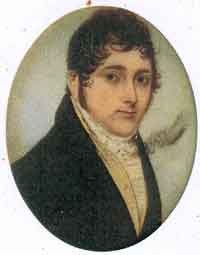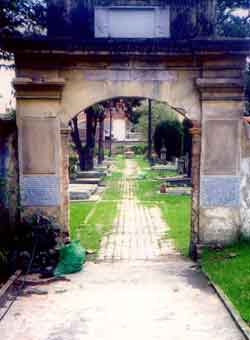|
(l)
Irish Legion Commemorative Medal
Sello
Conmemorativo de la Legión Irlandesa. Nineteenth-century
bronze medal made in England. c.1819. Reg. No. 700.
Inscription: 'Dios y Nuestra Cause [sic] La Legión
Irlandesa' (God and Our Cause The Irish Legion). (Brown and
Alonso Roa reproduction p. 229). Mentioned in the Nueva
Guía descriptiva
del Museo
de Bogotá (1886).
(m)
Tomás Carlos Wright
[27]
Oil on
cloth portrait by Antonio Salas.
[28] c.1824. Copy
from the Juan José Flores Archive, Pontifical Catholic
University of Ecuador
[29]
(n)
Tomás Murray [30]
Oil on
cloth portrait by Constancio Franco Vargas, José Eugenio
Montoya and Julián Rubiano.
[31] c.1880. Reg.
No. 268. (Brown and Alonso Roa reproduction p. 238). Mentioned
in the Nueva Guía descriptiva
del Museo
Nacional de Bogotá (1886).
|

Jeremías O'Leary Burke [?],
ca. 1835
(Catálogo de Miniaturas, 1993) |
The
miniatures of Jeremias and Daniel O’Leary are of more than
passing interest. [32] They are described as being of the
'English school' and while that may be so, it is this writer’s
belief that they are the work of the prolific Cork miniaturist
Frederick Buck. [33] Buck was renowned for 'the famous pink
complexion […] in its worst manifestation, this is an overall
pinkness, not merely rosy cheeks, and can be bestowed on man
or woman.' He was a 'man of habit. Having found his ideal
background, he stuck to it. He also stuck to his favourite
pose, which was three-quarter face, with the setter looking to
the right. He used this position whenever possible, sometimes
even when painting husband and wife as a pair […] He eschewed
profiles, in contrast to his brother Adam who specialised in
them…' [34] All of these characteristics are clearly evident
in these three O’Leary miniatures. Buck may well have painted
Daniel Florence O’Leary when the latter visited Cork in 1834.
The
O’Leary family is an interesting one. Daniel Florence married
Soledad Soublette, the sister of Bolívar’s Chief of Staff, and
the future president of Venezuela, General Soublette. They had
a large family of five sons and four daughters. Four of the
children were educated in Europe and a grandson, also named
Daniel Florence O’Leary, settled in Great Britain and
established a branch of the family there.
[35] Some of
O’Leary’s letters were at one time on display at the Museo
Nacional in Bogotá. On returning to Colombia after living for
a time in Jamaica and at Puerto Cabello in Venezuela, O’Leary
lived quietly with his wife and children at his estate ‘El
Chocho’ near Fusagasuga on the savannah of Bogotá.
[36] In
March 2005, Michael O’Leary of Cork, his cousin Peter O’Leary,
a great grandson of Daniel Florence O’Leary, accompanied by a
five-member group from Cork, gathered at the Panteón de los
Heroes in Caracas to lay a wreath in honour of the memory of a
revered hero. [37]
Richard
Vawell, [38] a Cambridge graduate from Cork, is a chronicler
who did not possess O’Leary’s talent. O’Leary’s memoirs are
the best contemporary account of the South American
revolutions by Latin American or European authors such as
O’Connor, Millar or Cochrane. Varwell has however left one
marvellous description of an unexpected encounter with a
compatriot. 'El propietario de la plantación era un irlandés
de nacimiento, llamado FitzPatrick, establecido desde hacía
mucho tiempo en el país; estaba casado con una criolla que le
había dado numerosa descendencia. Era la primera visita que
hubiese recibido de compatriotas, en aquel país, y pareció muy
asombrado del singular azar que se le procuraba. […] y era
ostensible su mucha satisfacción al conversar con nosotros en
su lengua materna, que no hablaba hacía años. (The owner of
the plantation was an Irish-born man named FitzPatrick who had
been settled in the country for a long time; he was married to
a Creole woman with whom he had many children. It was the
first visit of compatriots that he had received in that
country, and he seemed quite astonished by the singular chance
which had resulted in the meeting. [...] and his deep
satisfaction was evident in conversing with us in his native
tongue which he had not spoken for years.)'
[39]
The
British Cemetery, Bogotá

Central archway at the
British Cemetery of Bogotá
(Photo: Edward Walsh 2005) |
The
British Cemetery in Bogotá
[40] is located on Calle 26, next
to the sprawling central cemetery.
[41] In 1825 the British
community was given a burial plot on the road to Zipaquirá.
Two years later this plot was exchanged for another at San
Victorino and finally the existing property located in the
suburb of San Diego was obtained in 1829. In 1835 this land
was surrounded by a wall. The first burial registered at the
British Embassy is dated 1830. Some soldiers of the British
Legion and their descendants are buried in the cemetery. The
British Consul was responsible for burials and for maintaining
the relevant registers. In 1994 responsibility for the
operation and maintenance of the cemetery was passed from the
British Consulate to the resident British community.
[42]
Just
inside the gate from the street and close to the main entrance
there is a bungalow-style gate lodge with listed building
status which has been declared national patrimony. A resident
caretaker lives in this house. The gate from the street is
kept locked and access is restricted to prevent theft,
vandalism and desecration of graves. The front garden section
is separated from the inner burial area by metal railings made
from canons and bayonets from the Colombian War of
Independence. [43] A tree-lined avenue leads to a formal
gateway and the actual burial area.
[44] There are identical
engraved stone plaques on both pillars and among the three
inscriptions there is one which reads 'Captain Charles Smith
of Ireland, who died at Bogotá on 3rd April 1853 aged 63
years.' Among the tombs and gravestones, some with faded and
illegible inscriptions, there are two further inscriptions of
Irish interest: 'Agnes Conley, Lissnafillan,
[45] Ireland 1868
- Bogotá 1945' and 'Marie Carrick O´Connor, 26 March 1912 - 10
March 2003.'
|

A la memoria ... del
capitán Charles Smith, natural de Irlanda, muerto a los
63 años en Bogotá, el 3 de Abril de 1853'
(Photo: Edward Walsh 2005)' |
Little is
known concerning Irishman Thomas Fallon,
[46] medical doctor
and naturalist. He was called by the government to work at the
silver mines of Santa Ana, near Mariquita. Here he met Marcela
Carrión y León by whom he had three children - Diego
[47] the
celebrated poet, Tomasa and Cornelia.
Edward
Walsh
Acknowledgements
I am
indebted to María Cristina Cortés Sierra and Cathy Wilson of
the Royal Institute of British Architects Information Centre,
London; Edmundo Murray, Geneva; Flemming Skude, Copenhagen;
Edgar Arrevalo, Peter Simon, Luis Enrique Velásquez, Don Jorge
Guillermo Cortés Cuéllar, Doctor Felipe Zapata of the
Fundación Beatriz Osorio and Magda Martínez Roberto, Casa
Museo Mercedes Sierra de Pérez 'El Chico', all of Bogotá, for
their assistance with precise details. The writer would
particularly like to thank Cristina Lleras, curator of the art
and history collections at the Museo Nacional, Bogotá, for
permission to reproduce illustrations of the three miniatures
pertaining to Daniel Florence O'Leary which appear in the
Catálogo de las Fundaciones de Beatriz Osorio.
Notice
Since
writing this article I have been advised by Cristina Lleras
that a new and exhaustive study about Danish architect Thomas
Reed [48] has been published which changes much of what was
written about him by Silvia Arango.
[49] The new study
is:
Saldarriaga Roa, Alberto, Alfonso Ortíz Crespo and José
Alexander Pinzón Rivera, En Busca de Thomas Reed,
Arquitectura y Política en el Siglo XIX (Bogotá:
Panamericana Formas e Impresos, 2005).
Note of the Editor
We are
grateful to Daniel Pedrazzoli for his permission to publish
the illustration 'British Legion Private, 1821' in the last
page of this article. |




